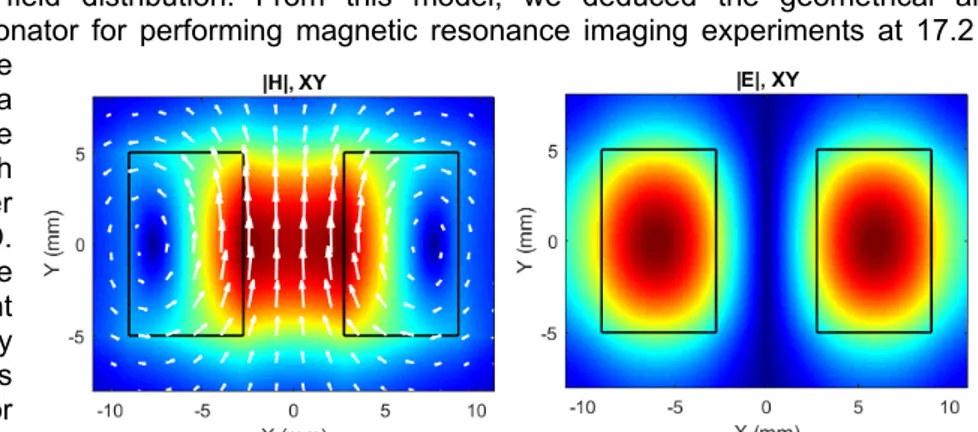HAL Id: hal-02516382
https://hal.archives-ouvertes.fr/hal-02516382
Submitted on 23 Mar 2020HAL is a multi-disciplinary open access
archive for the deposit and dissemination of sci-entific research documents, whether they are pub-lished or not. The documents may come from teaching and research institutions in France or abroad, or from public or private research centers.
L’archive ouverte pluridisciplinaire HAL, est destinée au dépôt et à la diffusion de documents scientifiques de niveau recherche, publiés ou non, émanant des établissements d’enseignement et de recherche français ou étrangers, des laboratoires publics ou privés.
Ferroelectric Ceramic Detectors for Ultra-High Field
Magnetic Resonance
Marine Moussu, Stanislav Glybovski, Julia Krug, Andrew Webb, Redha
Abdeddaim, Luisa Ciobanu
To cite this version:
Marine Moussu, Stanislav Glybovski, Julia Krug, Andrew Webb, Redha Abdeddaim, et al.. Ferro-electric Ceramic Detectors for Ultra-High Field Magnetic Resonance. Experimental Nuclear Magnetic Resonance Conference (ENC Conference), Mar 2020, Baltimore, United States. �hal-02516382�
Ferroelectric Ceramic Detectors for Ultra-High Field Magnetic Resonance
M. Moussu1,2, S. Glybovski3, J. Krug4, A. Webb5, R. Abdeddaim1, L. Ciobanu6
1Aix Marseille University, Marseille, France, 2Multiwave Innovation, Marseille, France, 3ITMO University,
Saint-Petersburg, Russia, 4Wageningen University, Wageningen,The Netherlands, 5Leiden University Medical Center,
Leiden, The Netherlands, 6CEA/DRF/NeuroSpin, Gif-sur-Yvette, France
In Magnetic Resonance Microscopy (MRM), losses inherent to the probe and its interactions with the sample fundamentally limit the achievable Signal-to-Noise Ratio (SNR) and hence the spatial resolution. The reference volumetric probe for MRM is the solenoid, for which the performance is intrinsically limited by the electric field induced in the sample [1]. Here, we show that high permittivity ceramic ring resonators can overcome this limitation.
We developed a semi-analytical model to study the first transverse electric (TE) mode of high permittivity dielectric resonators in terms of frequency and field distribution. From this model, we deduced the geometrical and electromagnetic properties of such a resonator for performing magnetic resonance imaging experiments at 17.2 T (Larmor frequency 730 MHz). The
prototype, shown in Fig. 2, consisted in a specially created 50/50 low-loss composite of BaTiO3/SrTiO3 with Mg additives [2], with the following geometrical parameters: outer diameter O.D. = 18 mm, inner diameter I.D. = 5.5 mm and height h = 10 mm. The composite properties, measured at ambient temperature, were: real relative permittivity 536 and loss tangent 8.10-4. Fig. 1 depicts the field distribution of the excited resonator TE01 mode, which demonstrates a
maximum of magnetic field together with low electric field values in the sample region. These features diverge from those of the solenoid in which magnetic and
electric fields experiment equivalent variations (concomitant high magnetic and high electric fields). Accordingly, the theoretical SNR was higher for the ceramic resonator than for a solenoid with similar size (theoretical SNR gain= 2.5). For MR experiments at 17.2 T, the first transverse
electric mode was excited with a loop (inner diameter 1 cm) placed close to the resonator. The latter was tuned to 730 MHz by imposing its temperature to be 21.8°C using a circulating water pad. The reference solenoid coil, built for comparison, had a similar internal volume and was designed to maximize the SNR according to Ref. [4] (4 turns, diameter 5.5 mm, height 12 mm, 1.5 mm thick copper wire). In experiments performed on the test solution (relative permittivity 50 and conductivity 0.5 S.m-1), the SNR gain was 2.2, as
demonstrated in Fig.2.
To conclude, we demonstrate, experimentally at 17.2T and theoretically using the first transverse electric mode (TE), that ceramic resonators provide a two-fold SNR gain when compared to
optimal solenoids. In addition, preliminary results obtained when exploring the first hybrid mode (HEM) of the same resonator type, show the potential of its use at a higher operating frequency (950MHz).
References:
[1] Park, J. Magn. Res., 2009.
[2] Nenasheva, E.A. Ferroelectrics, 2017.
[3] Moussu, M., Ciobanu, L. et al., Advanced Materials, 2019. [4] Minard K.R. Concepts Magn. Reson., 2001.
Acknowledgements: This project received funding from the European Union’s Horizon 2020 research and innovation program (grant agreement No. 736937) and from the Russian Foundation for Basic Research (grant No. 18-32-20115).
Fig. 1: Calculated field distribution of the transverse electric mode in the ceramic ring resonator filled with a sample of relative permittivity 50 and conductivity 0.5
S.m-1. (left) Magnetic field amplitude and field lines. (right) Electric field
amplitude. 𝑑 7 mm 𝑑 1.5 mm 𝑙 12 mm I. D. 5.5 mm 𝑛 4 ℎ 10 mm I. D. 5.6 mm O. D. 18 mm
Fig. 2: (top) Photographs of the solenoid and the ceramic coil. (bottom) Experimental validation of the theoretically predicted SNR gain.
